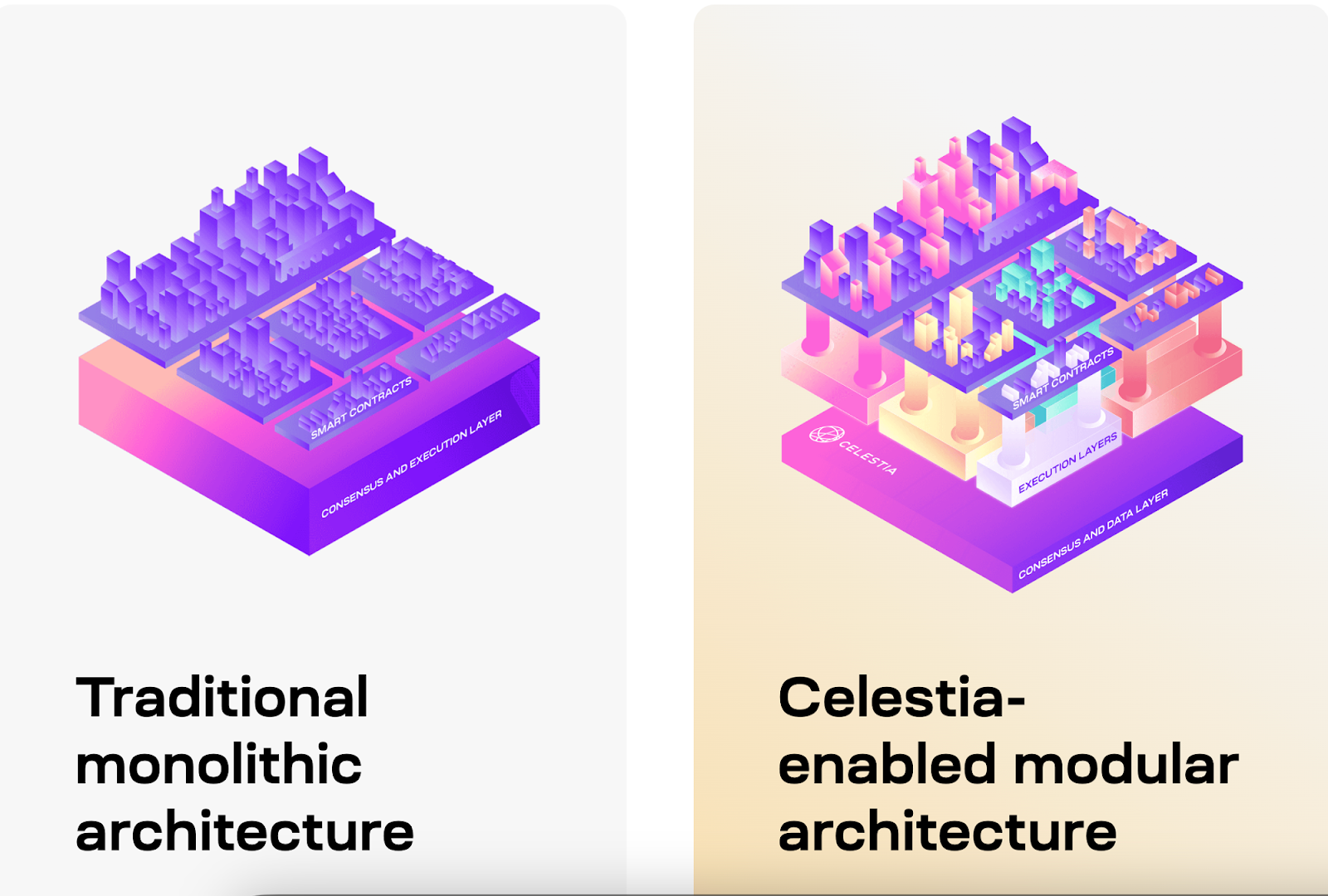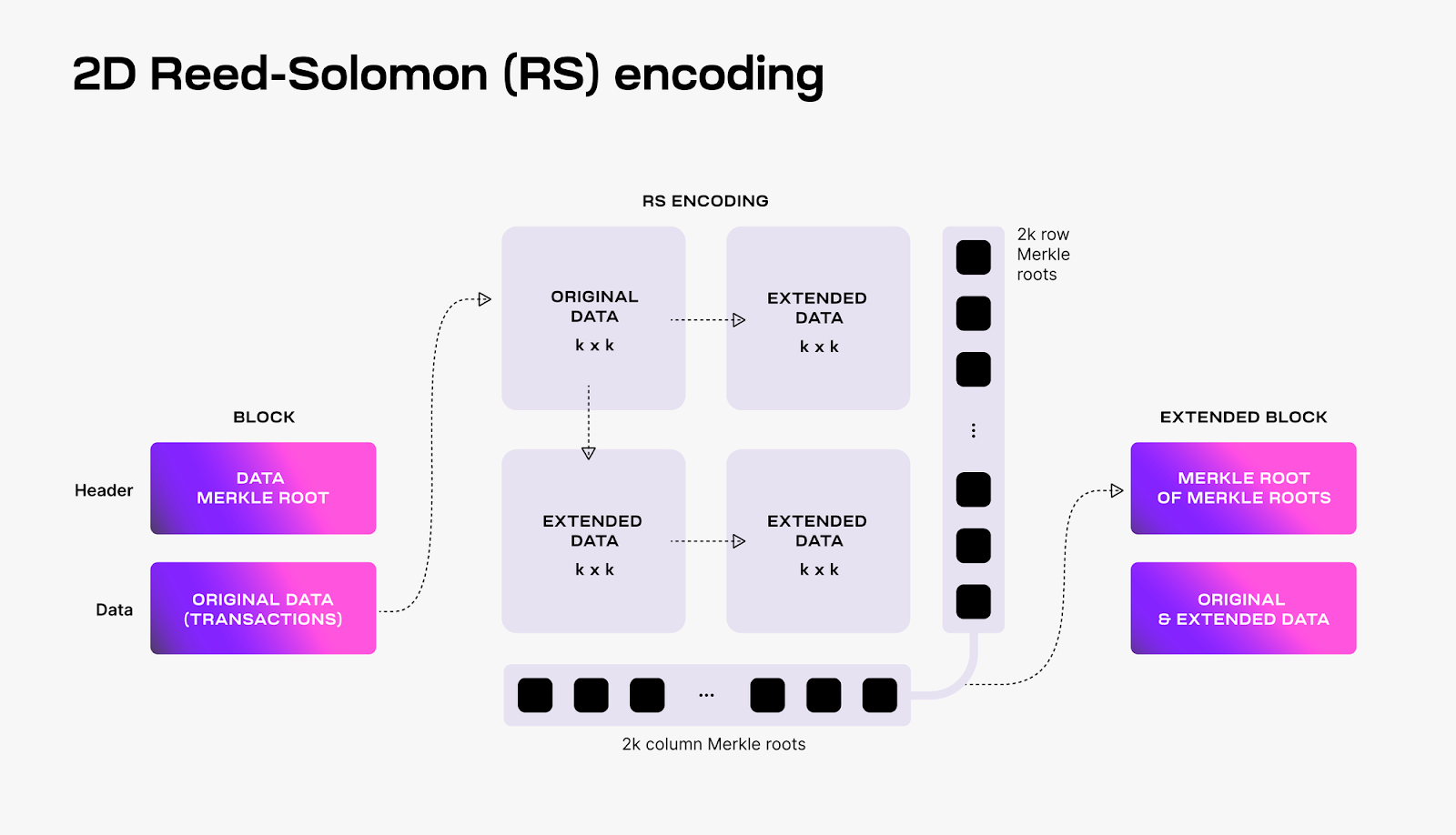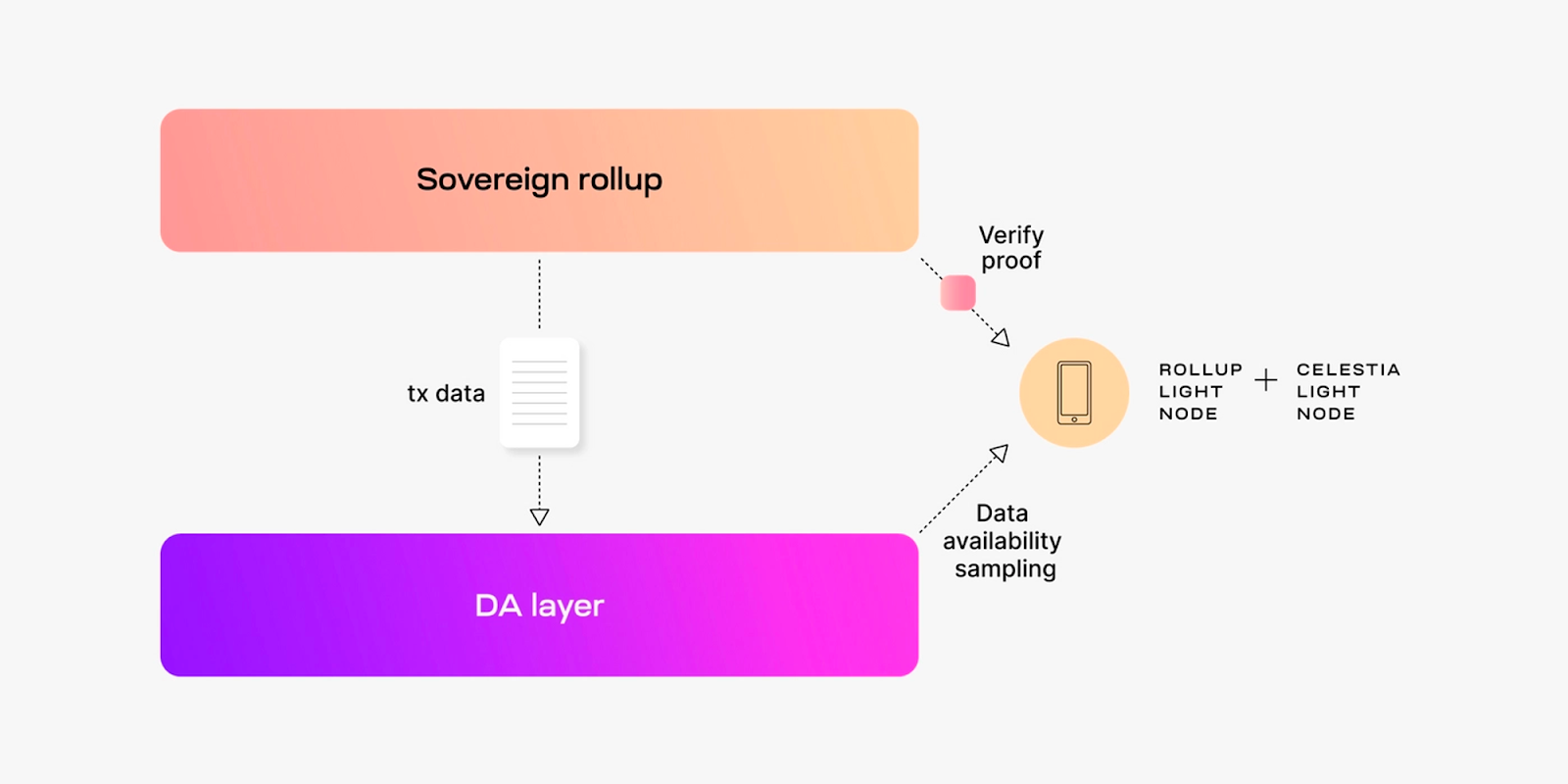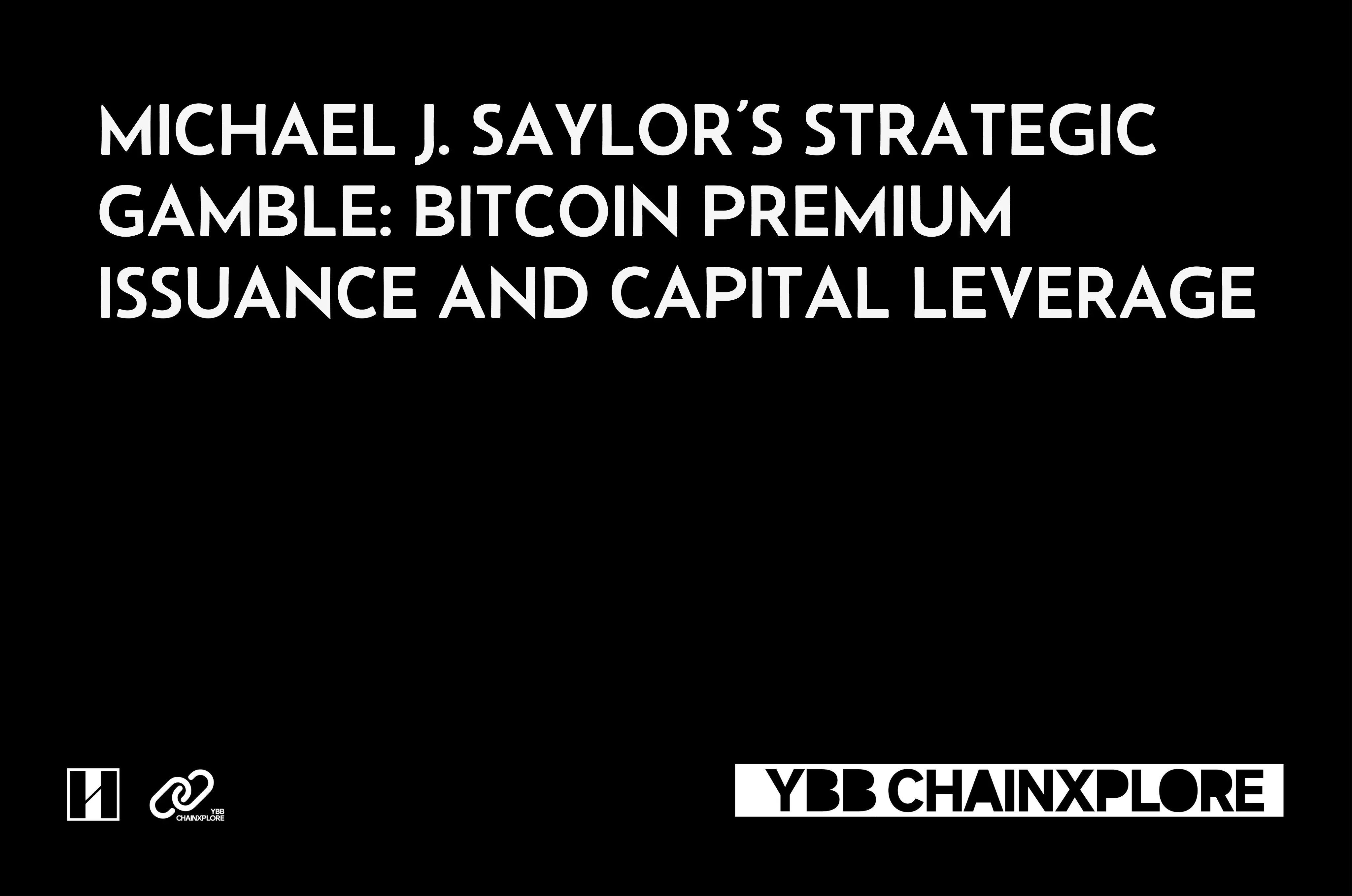Modular Blockchain: A New Perspective on Functional Layer Controversies and DA Economics
Author: Zeke, YBB Capital
Introduction
The blockchain trilemma has long been an insurmountable gap in the industry, with numerous public chain projects attempting to bridge this divide through various architectural designs, aiming to become the so-called "Ethereum killers." However, the reality is harsh; Ethereum's position, second to none, has never been surpassed over the years, and the impossibility of the blockchain trilemma remains unbroken. So, is there a way to fill the gaps of public chains and address the impossible triangle? Mustafa Albasan's idea of modular blockchain is rooted in this inquiry.
The Origin of Modularity
The birth of modular blockchain stems from two white papers. In 2018, Mustafa Albasan co-authored a paper titled "Data Availability Sampling and Fraud Proofs" with Vitalik. This paper described a system that allows light clients to receive and verify fraud proofs from full nodes, and designed a data availability proof system that reduces the trade-off between on-chain capacity and security, thereby addressing blockchain scalability without sacrificing security and decentralization.
Then in 2019, Mustafa Albasan wrote the white paper for "Lazy Ledger," which detailed a new architecture where the blockchain is only responsible for ordering and ensuring the availability of transaction data, without executing and verifying transactions. The purpose of this architecture is to solve the scalability issues of existing blockchain systems. He referred to this as the "smart contract client."
The execution of smart contracts is carried out by another execution layer on this client, which is the prototype of Celestia. The subsequent emergence of Rollups made this concept more certain, as the logic of Rollups is to execute smart contracts off-chain and then aggregate the results into proofs uploaded to the execution layer of the "client."
By reflecting on the architecture of blockchains and new scaling technologies, he defined a new paradigm and termed it "Modular Blockchain."
What is a Modular Blockchain
The architecture of traditional monolithic blockchains typically consists of four functional layers:
- Execution Layer ------ The execution layer is primarily responsible for processing transactions and executing smart contracts. It includes transaction validation, execution, and state updates;
- Data Availability Layer ------ The data availability layer in a modular blockchain is responsible for ensuring that data in the network can be accessed and verified. It typically includes functions such as data storage, transmission, and verification to ensure the transparency and trust of the blockchain network;
- Consensus Layer ------ Responsible for the protocol among nodes to achieve consistency of data and transactions in the network. It verifies transactions and creates new blocks through specific consensus algorithms, such as Proof of Work (PoW) or Proof of Stake (PoS);
- Settlement Layer ------ Responsible for the final settlement of transactions, ensuring the transfer of assets and permanent recording on the blockchain, determining the final state of the blockchain.
Monolithic blockchains integrate the work of these components within the same system, and this highly integrated design inevitably leads to some inherent issues, such as poor scalability, lack of flexibility, and difficulties in maintenance and updates.
Celestia believes that monolithic blockchains no longer need to do everything themselves. The future evolution of Web3 will be "modular blockchains," which modularize blockchains and allocate their processes to multiple "dedicated layers," each responsible for handling specific functional layers, thereby creating a better system that should possess independence, security, and scalability.
Principles of Modular Design
If a design breaks down a system into smaller parts that can be exchanged or replaced, then that design is modular. The core idea is to focus on doing part of the work well (operating on a part or single functional layer) rather than trying to do everything. For example, Cosmos Zones and Polkadot Parachains can be seen as forms of modularity.
New Perspectives
From the perspective of modularity, the redesign space for monolithic blockchains and their associated modular stacks will greatly increase. Modular blockchains, with different purposes and architectures, can achieve collaborative work through combinations. Under the diverse possibilities of design, this track has also given birth to many interesting innovative projects. The following will discuss the current controversies regarding different functional layers from a modular perspective and how Celestia interprets "modularity."
Execution Layer Centered Around Ethereum
If we consider Rollups as the modular execution layer, we will find that almost all projects of the modular execution layer are built on Ethereum. The reason is self-evident; Ethereum has abundant resources as a moat and the highest degree of decentralization among the options, but its scalability is poor, so there is great potential for redesigning the functional layer. The stark contrast between the recent underwhelming performance of Move-based language public chains (Aptos, Sui) and the unprecedented prosperity of Layer 2 on Ethereum also indicates that the narrative of blockchain infrastructure has shifted from building public chains to building Layer 2 on Ethereum. So, is the existence of modularity good or bad? Does the execution layer centered around Ethereum stifle innovation in public chains?
Blockchain Scalability Landscape
First, let’s reclassify existing chains from the perspective of the execution layer. Here, we reference Nosleepjon's article "Tatooine's Twin Suns" to explain the current classification of execution layers in blockchain.
Current blockchains can be divided into four categories:
1. Single-threaded Monolithic Blockchain: A monolithic blockchain that processes one transaction at a time. Due to limitations, most of these have turned to Rollup or horizontal scaling roadmaps.
Representative projects: Ethereum, Polygon, BNB Chain, Avalanche
2. Parallel Processing Monolithic Blockchain: A monolithic blockchain that processes multiple transactions at once.
Representative projects: Solana, Monad, Aptos, Sui
3. Single-threaded Modular Blockchain: A modular blockchain that processes one transaction at a time.
Representative projects: Arbitrum, Optimism, zkSync, Starknet
4. Parallel Processing Modular Blockchain: A modular blockchain that processes multiple transactions at once.
Representative projects: Eclipse, Fuel
Monolithic Parallel Processing Architecture vs. Modular Architecture
Currently, there are many opinions on which solution to adopt, especially in the comparison between modular and overall parallel processing concepts. The camps can be divided into three:
Modular Camp: Modular advocates (most of whom are also Ethereum supporters) believe that monolithic blockchains cannot solve the blockchain trilemma. Only by stacking Legos on Ethereum can scalability be achieved while maintaining security and decentralization. Moreover, modularity offers more control and customization.
Monolithic Parallel Processing Camp: This camp (citing Kodi and espresso in "Monolithic vs. Modular: Who is the Future of Blockchain?") argues that the new public chain architecture of single-threaded parallel processing (Move-based, Solana, etc.) has high integration, and overall performance will outperform the fragmented design of modularity. Additionally, the modular architecture is not secure, especially as it requires extensive cross-chain communication, which broadens the attack surface for hackers.
Neutral Camp: There are also those who hold a neutral stance, believing that both can ultimately coexist. For example, Nosleepjon believes that the endgame of this game is: both have their advantages, competition among public chains will continue, and Rollups will compete with each other.
EndGame
The crux of this issue can actually be simplified to whether the friction drawbacks of modularity (cross-chain insecurity, system inefficiency, etc.) outweigh the centralization issues of new public chains. From the market perspective, this debate—whether it’s the flaws of centralized Rollup sequencers or the potential dangers of cross-chain bridges—has not led people to turn to new public chains. This is because these issues currently seem to have room for improvement, while new public chains cannot replicate the vast ecological moat and decentralization advantages of Ethereum.
On the other hand, while new public chains have performance and integration advantages in architecture, they are merely simple forks of the Ethereum ecosystem, with excessive homogeneity and a lack of liquidity. There are no standout applications that can showcase their architectural advantages, so there is no compelling reason for people to abandon the Ethereum ecosystem. Meanwhile, the plasticity of Rollups is high, and there is still significant room for improvement in future new architecture Rollups. When Rollups also possess most of the advantages of non-EVM chains, situations like "Solana Summer" are unlikely to occur again. Therefore, I believe that the friction drawbacks of modularity are less than the centralization issues of public chains. The neutral situation seems to be non-existent, as Ethereum's siphoning effect will attract a large number of developers focused on scalability to Layer 2, while new public chains will become ghost towns.
Regarding the future of infrastructure, I undoubtedly lean towards modularity. Ethereum's segmented scaling will mark the beginning of the EndGame for public chain games, with Layer 2 competing for general chains and Layer 3 competing for super application chains.
The current situation of projects raising funds in the primary market also confirms this point. Apart from a large number of Ethereum Layer 2 projects, there are almost no new public chains in comparison to Bitcoin's scaling projects.
However, that said, the industry is still developing based on Ethereum, and the current trend seems a bit overly centralized. Is this situation really good? A lack of competition can stagnate the development of an industry; diversity and more choices are needed. But how new public chains can create a breakthrough remains to be seen. As Ethereum continues to improve its shortcomings, how to find larger gaps for precise strikes is a key consideration for non-EVM systems.
The Arena of DA Solutions
Having discussed the controversies surrounding the execution layer, let’s look at the disputes regarding the Data Availability (DA) layer. The debate over which data availability solution Rollups should adopt has recently become a hot topic in the industry, sparked by a tweet from Ethereum Foundation researcher Dankrad Feist discussing related topics. In his view, Rollups that do not use Ethereum DA are not Layer 2. So, will the past Layer 1 wars evolve into a battle between orthodox (using Ethereum DA) Layer 2 and unorthodox Layer 2? Currently, the main DA solutions in the industry are as follows:
1. Public Chain as Settlement Layer
Taking Ethereum as an example, when a Rollup conducts a transaction, the fees submitted to Ethereum mainly include the following categories:
Execution Fee: Compensation for the computational resources required to execute transactions. It includes the gas fees needed for executing transactions, which are usually proportional to the complexity and execution time of the transaction. In Rollups, execution fees may include the costs of executing transactions off-chain, as well as the costs of generating and verifying transaction proofs;
State Fee: The state fee is related to updating the state on the Ethereum main chain. In Rollups, this includes the fees for submitting the new state root to the main chain. Every time a Rollup aggregator generates a new state root and submits it to the main chain, a state fee is incurred. This fee may be proportional to the frequency and complexity of state updates;
Data Availability Fee: The fee for publishing data to Layer 1.
Among these fees, the data availability fee accounts for the largest proportion and is quite expensive. For example, on May 6 of this year, due to a surge in Ethereum's gas fees, Arbitrum paid a staggering 376.8 ETH in gas fees in a single day.
This is because Rollups upload data to Ethereum in the form of calldata, and this data is permanently stored, making the costs very high. However, the advantage is that it has the best security and orthodoxy among the three solutions. The cost of this solution needs to wait for the EIP-4844 update in the Cancun upgrade. By introducing a transaction format called Blob carrying Transactions, this format adds a Blob position to store Layer 2 data compared to the regular transaction format. Moreover, Blob data will be deleted by nodes after one month, significantly saving storage space.
The Blob transaction format can provide cheaper data availability than calldata for two main reasons: on one hand, calldata exists in the Execution Payload, while Blob data is stored in Prysm nodes or Lighthouse nodes (rather than in Geth), making the resources consumed by calldata much higher when contracts need to read it; on the other hand, Blob data is stored temporarily, and nodes will delete Blob data after one month. However, its gas fees will still be higher than the latter two solutions.
2. Validiums DA Model
For application chain-type Rollups (such as the former dYdX, Immutable, etc.), they typically use Layer 2 scalability engines launched by leading Rollup projects (currently, StarkEx is the most common, but leading ZK projects have similar solutions). In terms of DA models, since application chains have a larger computational load, they tend to prefer using Validiums, which are low-cost and high-throughput solutions. The principle of Validiums is to utilize off-chain data availability and computation to design, similar to ZK-Rollups, by publishing zero-knowledge proofs to verify off-chain transactions on Ethereum. However, unlike ZK-Rollups, which keep data on-chain, Validiums keep data off-chain, resulting in a 90% reduction in costs compared to using Ethereum, making it the most cost-effective solution in selectable scenarios.
However, since data is kept off-chain, Validium's entity operators can freeze users' funds. To prevent extreme situations, a Data Availability Committee (DAC) solution must be introduced, where the DAC must sign off on each state update with its quorum to confirm it has received the data. This is a controversial practice because you must first trust the security of the entities rather than the chain. Dankrad Feist (the proposer of EIP-4844 mentioned above) directly pointed out this solution in his tweet.
3. Modular DA
From the perspective of modularity, the redesign of the DA layer can take various forms, which may lead to significant differences in the specific implementation of different projects. Therefore, a detailed explanation of modular DA projects requires extensive coverage, and here we will use Celestia as a representative to explain DA projects.
Celestia
As the first proposer of the modular blockchain concept, Celestia is the most well-known and earliest project in this track. Its vision aims to solve the problems of blockchain scalability and modularity. Celestia provides developers with more flexibility, making it easier for them to deploy and maintain blockchain applications. At the same time, it reduces the cost and complexity of deploying blockchains, offering a modular and scalable blockchain architecture to meet the needs of various applications and services.
Working Principle and Architecture
Decoupled Execution: The logic of Celestia is to divide the protocol into different layers, each focusing on specific functions, and then recombine these layers to build blockchains and applications. Celestia focuses on the consensus and data availability layers within this hierarchy. Similar to some Layer 1s, Celestia uses the Byzantine Fault Tolerance (BFT) consensus algorithm Tendermint for transaction ordering, but unlike other Layer 1s, Celestia does not infer transaction validity or execute transactions; it only packages, orders, and broadcasts transactions, with all transaction validity rules enforced by Rollup nodes at the client level (i.e., decoupling the consensus layer and execution layer). A key point to note is that "not inferring transaction validity" means that malicious blocks hiding transaction data can also be published to Celestia. So how should the verification process be implemented? Celestia introduces two core components: two-dimensional Reed-Solomon coding and Data Availability Sampling (DAS).

Comparison of the overall architecture of monolithic blockchains with Celestia's modular architecture
DAS: This solution is used for light nodes to verify the availability of block data without needing to download the entire block. It only requires sampling part of the block's data (the specific implementation requires two-dimensional Reed-Solomon coding, which will be detailed later). Unlike the DAC mentioned above, DAS does not require trusting the security of entities; it only requires that the chain is sufficiently decentralized for the data to be trusted.
Two-dimensional Reed-Solomon Coding (Erasure Coding): The basic idea of two-dimensional Reed-Solomon coding is to apply Reed-Solomon coding to both rows and columns. This way, even if errors occur in certain rows and columns of the two-dimensional data, they can be corrected. By encoding block data, the block data is divided into kk blocks, arranged into a kk matrix, and expanded into a 2k2k extended matrix through multiple Reed-Solomon codings. The 4k independent Merkle roots of the rows and columns of the extended matrix are calculated; these roots' Merkle roots are used as commitments to the block data in the block header. Celestia's light nodes sample the 2k2k data blocks. Each light node randomly selects a set of unique coordinates from the extended matrix and queries full nodes for the data blocks and corresponding Merkle proofs regarding those coordinates. Each received data block with the correct Merkle proof will be broadcast to the network.
If we abstract this understanding, we can say that the block data is divided into a square matrix (for example, 8x8), and through encoding, additional "check" rows and columns are added to the original data, forming a larger square matrix (16x16). By randomly sampling part of the data from this larger square matrix and verifying its accuracy, the integrity and availability of the overall data can be ensured. Even if some data is lost or damaged, the check data can still be used to recover the entire block of data.

Block Scaling: Celestia scales with the increase in the number of light nodes. As long as there are enough nodes in the network to sample the entire block, Celestia will remain secure. This means that as more nodes join the network for sampling, the block size can increase accordingly without sacrificing security or decentralization. In traditional blockchains, doing so would sacrifice decentralization, as larger block sizes would increase the hardware requirements for nodes to download and verify data.
Sovereign Rollup: This is also a concept pioneered by Celestia, combining elements from various blockchain designs, including Layer 1 blockchains, Rollups, and early Bitcoin networks like Mastercoin. The key difference between sovereign Rollups and smart contract Rollups (OP, ARB, ZKS, etc.) lies in how transactions are verified. In smart contract Rollups, transactions are verified by smart contracts on Ethereum. In contrast, in sovereign Rollups, the nodes of the Rollup itself verify transactions.
Sovereign Rollups publish their transactions to another blockchain (such as Celestia) for ordering and data availability. The nodes of the sovereign Rollup then determine the correct chain. This design allows sovereign Rollups to inherit multiple security aspects from the data availability (DA) layer, including liveness, security, resistance to reorganization, and censorship resistance.

For smart contract Rollups, upgrades depend on the smart contracts on the settlement layer. Upgrading a Rollup requires changing the smart contract. Multi-signature may be needed to control who can initiate updates to the smart contract. While it is common for teams to control upgrade multi-signatures, governance may also make multi-signatures controlled. Since smart contracts exist on the settlement layer, they are also bound by the social consensus of the settlement layer.
Sovereign Rollups upgrade through forks similar to Layer 1 blockchains. A new version of the software is released, and nodes can choose to update their software to the latest version. If nodes disagree with the upgrade, they can continue using the old software. Providing options allows the community, i.e., the people running the nodes, to decide whether they agree with the new changes. Even if the majority of nodes upgrade, they cannot be forced to accept the upgrade. Compared to smart contract Rollups, this feature makes sovereign Rollups "sovereign" Rollups.
Quantum Gravity Bridge (QGB): A key component of the Celestia ecosystem, it serves as a bridge between Celestia and Ethereum (or other EVM L1 chains), enabling data and asset transfers between the two networks. By introducing the concept of Celestium (EVM L2 Rollup), it uses Celestia for data availability but settles on Ethereum. This achieves the advantages of both networks: Celestia's scalability and data availability, along with Ethereum's security and decentralization.
Validators on Celestia can run QGB, providing strong data availability guarantees for block data at a cost lower than Ethereum's calldata.
QGB is a crucial part of Celestia's vision for a scalable, secure, and decentralized blockchain ecosystem. It realizes the interoperability required for the future of blockchain technology. The project is currently also developing Zk QGB to further reduce the gas costs of verification.
DA Economics
Let’s discuss the economic value of DA.

This hypothesis is based on Polygon Hermez's expectation that they will ultimately need only 14 bytes per transaction. Under the current Danksharding specification of 1.3 MB/s, Layer 2's TPS could reach around 100,000, leading to an estimated revenue of an astonishing $30 billion.
With such a massive pie, the future disputes in the DA market will be very intense. Currently, in addition to the three mainstream solutions, there are Stark's fragmented scaling Layer 3, zkPorter, and multiple modular DA projects that will join the fray. From the existing Layer 2 projects, general chains are completely inclined to use Ethereum DA. Application chains and long-tail chains will be the main customers of "non-orthodox DA." My personal view is that modular DA and the upcoming Layer 3 will become the mainstream choices in the future.
Conclusion
Moving forward in decentralization remains the mainstream view of this industry. Modular blockchain is essentially an extension of Ethereum's value and an attempt to break the blockchain trilemma. Although the design is full of diversity, it also makes construction more cumbersome and complex. In modular construction, the various choices of modules mean that the risks of different modules are like blind boxes; how to build a relatively stable modular system is something to pay attention to. On the other hand, the influence of the modular trend will also lead to the liquidity of dozens of Layer 2s being split again, and cross-chain communication and security will be key focuses in the future. Additionally, the modularization of BTC is also a relatively hot direction recently, and there are some slightly feasible solutions that deserve attention.









